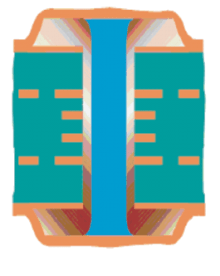SPRAAV1C May 2009 – March 2020 AM3703 , AM3715 , OMAP3503 , OMAP3515 , OMAP3525 , OMAP3530
-
PCB Design Guidelines for 0.4mm Package-On-Package (PoP) Packages, Part I
- Trademarks
- 1 Using This Guide
- 2 A Word of Caution
- 3 A Team Sport
- 4 Be Wary of Quotes
- 5 Don’t Forget Your CAD Tools
- 6 Metric Vs English
- 7 PCB Fab Limits
- 8 Routing and Layer Stackup
- 9 OMAP35x 0.4mm Pitch
- 10 Pad Type
- 11 PCB Pad Dimensions for 0.4mm BGA Package
- 12 Multiple BGA Packages
- 13 Etch Traps and Heat Sinks
- 14 Vias and VIP
- 15 Laser Blind Vias
- 16 Filled Vias
- 17 Know Your Tools
- 18 BeagleBoard
- 19 BeagleBoard Views
- 20 OMAP35x Decoupling
- 21 PCB Finishes for High Density Interconnect (HDI)
- 22 Real World Second Opinion
- 23 Acknowledgments
- 24 References
- Revision History
16 Filled Vias
After drilling, and depending on the board fabricator preferences, the BeagleBoard vias were filled with non-conductive epoxy. It was used because it has a better match to the thermal expansion properties of the board material.
Once the vias are filled, cured, and planarized, they are then plated. This yields a flat copper plated cap over the vias which facilitates component attachment. The VIP technology provides two primary benefits: higher component density and improved routing.
 Figure 14. Plated, Filled and Capped BGA Pad
Figure 14. Plated, Filled and Capped BGA Pad All vias must be capped or filled to prevent voids and out gassing. The images in Figure 15 show the effect of an uncapped via. The voids and damage occurs during reflow. The right picture is a failure caused by the excessive package movement during reflow, caused by out gassing.
 Figure 15. Effect af an Uncapped Via
Figure 15. Effect af an Uncapped Via It is strongly recommended that all vias be tented, filled or capped, especially under BGA packages.
Be sure to consult with your board fabricator prior to specifying via fill to establish their manufacturing requirements. Also, make sure your CAD system provides the required design files and the needed documentation. In some cases, additional files may be required.
Tom Hausherr, from PCBLibraries (www.pcblibraries.com), has a very good presentation covering various types of vias and via coverings. His presentation, Metric Pitch BGA and Micro BGA Routing Solutions, can be found on their website. Read that material since this application report only highlights the three most commonly used types of vias and via coverings.